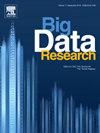The influence of China's exchange rate market on the Belt and Road trade market: Based on temporal two-layer networks
IF 4.2
3区 计算机科学
Q2 COMPUTER SCIENCE, ARTIFICIAL INTELLIGENCE
引用次数: 0
Abstract
From 2010 to 2023, this research utilizes daily closing exchange rate data for countries participating in the Belt and Road Initiative (BRI) as well as China’s import and export volumes with these countries. Taking the renminbi (RMB) as the base currency and the other BRI currencies as quote currencies, we employ the Autoregressive Distributed Lag (ARDL) model to propose an algorithm for constructing a temporal two-layer network, resulting in the exchange-rate-trade network composed of 14 subnetworks. Through an analysis of the network’s topological structure, we observe that 2013 marks a significant turning point, after which the network transitions from a decentralized to a more centralized form. To assess the annual impact of China’s exchange rate and trade from 2010 to 2023, we introduce a comprehensive index for identifying key nodes within the network. Our findings based on this index indicate that: (1) Lebanon, Kyrgyzstan, and other diverse countries and regions emerge as key nodes, demonstrating China’s close economic ties with these countries and reflecting the substantial influence of RMB internationalization; and (2) compared with other years, China’s exchange rate market exerts notably stronger influence on the trade market in 2018, 2021, 2022, and 2023.
中国汇率市场对“一带一路”贸易市场的影响——基于时间双层网络
从2010年到2023年,本研究使用了参与“一带一路”倡议(BRI)的国家的每日收盘汇率数据以及中国与这些国家的进出口贸易额。以人民币为基准货币,其他一带一路货币为报价货币,采用自回归分布滞后(ARDL)模型,提出了一种构建时间双层网络的算法,得到了由14个子网络组成的汇率-贸易网络。通过对网络拓扑结构的分析,我们观察到2013年标志着一个重要的转折点,之后网络从分散的形式转变为更集中的形式。为了评估从2010年到2023年中国汇率和贸易的年度影响,我们引入了一个综合指数来识别网络中的关键节点。基于该指数的研究结果表明:(1)黎巴嫩、吉尔吉斯斯坦等不同国家和地区成为关键节点,表明中国与这些国家的经济联系密切,反映了人民币国际化的实质性影响;(2) 2018年、2021年、2022年和2023年中国汇率市场对贸易市场的影响明显强于其他年份。
本文章由计算机程序翻译,如有差异,请以英文原文为准。
求助全文
约1分钟内获得全文
求助全文
来源期刊

Big Data Research
Computer Science-Computer Science Applications
CiteScore
8.40
自引率
3.00%
发文量
0
期刊介绍:
The journal aims to promote and communicate advances in big data research by providing a fast and high quality forum for researchers, practitioners and policy makers from the very many different communities working on, and with, this topic.
The journal will accept papers on foundational aspects in dealing with big data, as well as papers on specific Platforms and Technologies used to deal with big data. To promote Data Science and interdisciplinary collaboration between fields, and to showcase the benefits of data driven research, papers demonstrating applications of big data in domains as diverse as Geoscience, Social Web, Finance, e-Commerce, Health Care, Environment and Climate, Physics and Astronomy, Chemistry, life sciences and drug discovery, digital libraries and scientific publications, security and government will also be considered. Occasionally the journal may publish whitepapers on policies, standards and best practices.
 求助内容:
求助内容: 应助结果提醒方式:
应助结果提醒方式:


